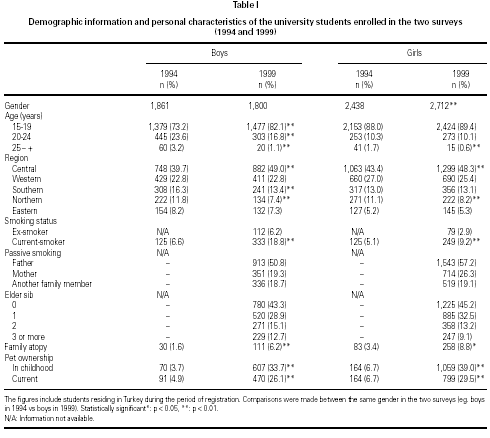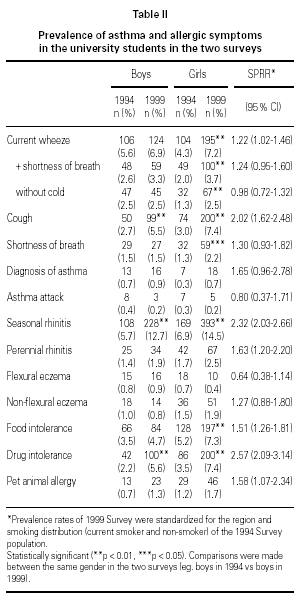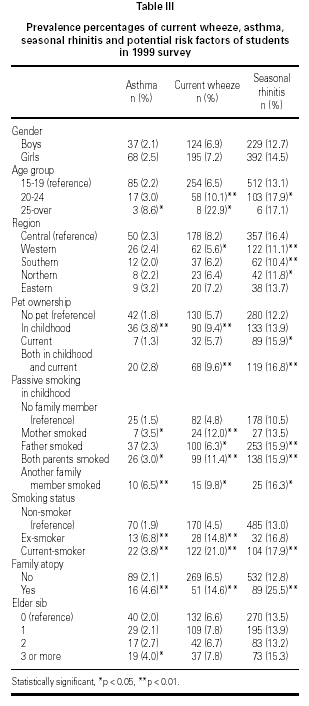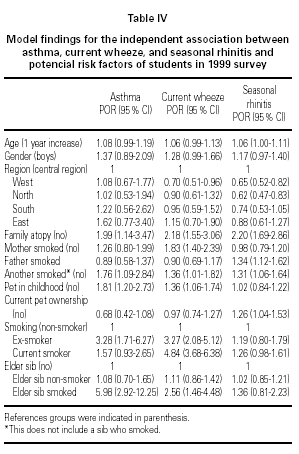INTRODUCTION
Evidence exists for the increasing prevalence of asthma and allergic diseases in the last decades (1-3). As different definitions of asthma have been used in the studes investigating the status of asthma some the differences in the prevalence colud be due to the methodological differences. European Community Respiratory Health Survey (ECRHS) and International Study of Asthma and Allergic Diseases in Children (ISAAC) in children used standard methodologies to assess the prevalence of asthma and make comparisions between and within countries (4, 5). Studies based on the standardized questionnaire used in these surveys found prevalence of asthma mainly below 5 % in adults from different parts of Turkey (6-8). Two across-sectional studies conducted 5 years apart among school children in Ankara, Turkey showed no significant change in the prevalence of asthma (9).
We present the findings of a survey among the first-year university students in Ankara. The aims were:
1. To determine the prevalence of asthma, and allergic diseases in the first-year university students.
2. To comparate the prevalence of asthma, and allergic diseases with that of a similar study conducted 5 years ago (10).
3. To investigate the determinants of asthma, current wheeze and seasonal rhinitis.
MATERIAL AND METHODS
A self-administered questionnaire was mailed to the addresses of first-year university students who would be attending to Hacettepe University in 1999 september. During registration 4,639 of the 5,406 students (1,839 boys, 2,774 girls, 26: not indicated gender) completed and returned the questionnaires. Response rate (85.8 %) was slightly lower than that of the 1994 survey (94.2 %). In 1994 survey students filled the questionnaires, which were distributed during registration. The questionnaire used in 1999 included questions in the 1994 survey (10), and additional questions on smoking (age of onset, smoking in the past), passive smoking in childhood, and having sibs. Questions on respiratory and allergic symptomps were based on the questionnaire used in the ECRHS.
Current wheeze was defined as a report of wheezing or whistling sound breathing in the last 12 months. Diagnosis of asthma was defined as "Yes" response to the question: "Have you ever received the diagnosis of asthma by a physician?" Asthma was defined as a report of an asthma attack or being woken up with shortness of breath or using medicine for asthma in the last 12 months. Seasonal rhinitis was defined as having hay fever during spring months. Perennial rhinitis was defined if the symptoms lasted for all the year. Food intolerance was defined as a report os discomfort (sudden edema on the lips, tongue or in throat; sudden nasal discharge, nasal obstruction, sneezing, shortness of breath, wheezy breathing, sudden itching or syncope) after eating any food. Drug intolerance and pet animal allergy were defined as allergy to any drug and any pet animal, respectively.
Presence of seasonal rhinitis, asthma or atopic dermatitis in a first-degree relative was considered as a positive family history of atopy (family atopy). Description of smoking was provided in the questionnaire as ever smoked regularly at least one cigarette a day. Current smoking was defined as smoking at least once a week for a year or more. Students were categorized as ex-smoker, if they reported that they had stopped smoking within a year before the time of the study. Passive smoking was considered if there was a report of smoking in childhood of mother or father or a sib or another household member. Pet ownership was defined for having a cat and/or dog and/or bird at the time of study (current) and in childhood. Having an elder sib was categorized as 0, 1, 2, 3 and more elder sibs.
The region of residence was asked in the questionnaire. Turkey is divided into 5 geographical regions as Central, Western, Northern, Southern and Eastern regions. The university is in Ankara in the Central region, which has a dry climate. Western and the Central regions have the main industries, and high levels of air pollution. Northern and Southern regions are the coastal regions. The rainfall in the Northern region is the highest of the country. Diet of the Northern region depends mostly on vegetables and fish. Southern region has a hot climate and includes the main touristic places. Eastern region has an inland climate, very few plants, and scare industry. Diet of the Eastern region mostly depends on meat and cereal. Other regions have mixed dietary habits.
Statistical analysis
Data from the Turkish students residing in Turkey, with available information on gender, age and region (1,800 boys, 2,712 girls) were used in the analyses. Students who had been residing abroad were older, had a higher prevalence of smoking (girls), pet in childhood (boys), wheezing (boys) and lower prevalence of seasonal allergy as compared to the students residing in Turkey (p < 0.05 for all comparisons).
Chi-square test was used for the comparison of the prevalence. Yates'continuity correction was applied. A p value less than 0.05 was considered for statistical significance. P values less than 0.01 were also indicated. Prevalence of asthma and allergy symptoms in the 1999 survey was standardized to the region and smoking distribution of 1994 survey. Gender, region and smoking specific prevalence rates in the 1999 survey were applied to the region and smoking distribution of the 1994 survey. After the calculation of the standardized prevalence for boys and girls, the two were added giving each gender equal weight. The aim was control for the changes due to differences in the region and smoking distribution between the two surveys. Ex-smokers were excluded from the analysis, since information on ex-smokers was not provided in the 1994 survey. The variance estimator of the standardized ratio was calculate based on the Chi-square statistics. Multiple logistic regression analysis was used to assess the risk factors for current wheeze, asthma and seasonal rhinitis in the study population. Independent associations were expressed by prevalence odds ratio (POR) and 95 % confidence interval (95 % CI) of the estimates.
RESULTS
Table I shows the demographic information and personal characteristics of the university students in the two surveys. Students in the 1999 survey had a higher prevalence of female gender, younger age and residence in Central region than that of 1994 survey. Current smoking increased almost three times among the boys (6.6 % to 18.8 %), and almost two times among the girls (5.1 % to 9.2 %). Almost half of the boys and girls in the 1999 survey reported passive smoking in childhood. Information on smoking in the past, and passive smoking was not available in the 1994 survey. Family history of atopic disease and pet ownership in both childhood, and currently were significantly increased in 1999 as compared to that of 1994.
Prevalence of respiratory and allergic symptoms in presented in table II. In the 1999 survey there was a increased prevalence of being woken up with cough, seasonal rhinitis, and drug intolerance in both boys and girls. Prevalence of current wheeze, being woken up with shortness of breath, and food intolerance were increased in girls in the 1999 survey. Prevalence rate ratios of 1999 survey standardized for gender, region and smoking status was increased for current wheeze, being woken up with shortness of breath, perennial rhinitis, food intolerance and pet animal allergy by about 20-60 %. The increase was by two times or more for being woken up with cough, seasonal rhinitis and drug intolerance.
Table III shows crude associations between the personal characteristics and asthma, current wheeze and seasonal rhinitis in the 1999 survey. Asthma defined as asthma symptom or medicine in the last 12 months was detected in 37 (2.1 %) boys and 68 (2.5 %) girls. Prevalence of the three conditions (asthma, current wheeze and seasonal rhinitis) was higher in girls than that of boys, but did not reach statistical significance. Prevalence rates increased with age. Current wheeze and seasonal rhinitis were significantly more common in the Central region than the other regions. Pet ownership in childhood was significantly associated with asthma and current wheeze. Current pet ownership was significantly associated with seasonal rhinitis. Smoking of mother in childhood was significantly associated with asthma and current wheeze. Smoking of another household member in childhood was significantly associated with asthma, current wheeze and seasonal rhinitis. Current smoking increased the prevalence of asthma, current wheeze and seasonal rhinitis. Ex-smokers had a higher prevalence of asthma and current wheeze. Family history of atopy was significantly associated with asthma, current wheeze and seasonal rhinitis. The prevalence of asthma increased in the students who had 3 or more elder sibs as compared to students who had no elder sib.
Multiple logistic regression models adjusted for the independent association between asthma, current wheeze, and seasonal rhinitis and potential risk factors (table IV). Risk of asthma increased with family atopy, smoking in the past, pet in childhood and report of a sib or another household member having smoked in the student's childhood. Risk of current wheeze increased with family atopy, smoking in the past or currently, pet in childhood and report of mother or a sib or another household member having smoked in the student's childhood. Risk of seasonal rhinitis increased with age, family atopy, current pet ownership and report of father or another household member having smoked in the student's childhood. Western region had increased risk of current wheeze and seasonal rhinitis and seasonal rhinitis, and Northern region had increased risk of seasonal rhinitis as compared to the Central region. In a separate analysis risk of asthma, current wheeze, and seasonal rhinitis increased almost by 1.2-1.3 times with the increasing number of smokers (0 to 3) in childhood (results nor shown).
DISCUSSION
Our survey among the university students revealed increased prevalence of asthma symptoms and seasonal rhinitis in the last 5 years. There was a huge increase in the rate of smoking and pet ownership. Increased pet ownership was reflected by the increased prevalence of pet allergy. Self-administered questionnaires were used in both surveys. In 1994 survey students were asked to fill the questionnaires, while they were accomplishing the required tasks of the registration. In 1999 survey questionnaires were sent by mail to the students before the registration. Respondents could have more time before they answer the questions (better recall) in 1999 survey. This is a potential information bias and may have contributed to the huge increases in the reportes prevalence of asthma and allergic diseases and the exposures.
Standardization of the prevalence rates was performed to adjust for the changes in the distribution of gender, region and smoking. Since information on smoking in the past was absent in 1994 survey, ex-smokers were omitted in the standardization. Increases in the prevalence of asthma and allergy symptoms were mostly preserved after the adjustments. This suggests that the increases in the symptoms could at least partially be explained by differences in the distribution of region and smoking status between the two surveys. Increased prevalence of drug and food intolerance, if not due to recall bias, should be further investigated. Amount of cigarettes smoked might have also increased in the second survey students, and could have also contributed to the increased prevalence of respiratory symptoms. Asthma and allergy symptoms were reported more frecuently in girls than the boys. However this difference was not observed after the adjustments were made for the potential risk factors.
In Turkey high school graduates take a national exam to attend the universities. Thus our study population is more educated, urbanized, and has higher socioeconomic status as compared to the general Turkish population (of the same age group). Therefore our prevalence estimates os asthma and allergic diseases could be higher than that of Turkish population in the same age group. Increased prevalence of asthma has been reported in the urban than the suburban areas (11). In a study of 46,813 children aged 0-17 years from 27 cities in different regions of Turkey, risk of lifetime prevalence of asthma (but not current prevalence of asthma) increased in urban as compared to rural areas (12). Only 11 students participated in our study had a rural exposure to a farm animal. Among these only two reported being woken up with chest tightness and one being woken up with cough in the last 12 months.
Possible explanations for the increased prevalence of asthma and allergy include changes in the dietary habits and the chemicals in the cosmetics, which were increased during the last years. Increased public awareness of the allergic diseases in the last years could have enhanced the recall of these diseases and symptoms. Public vaccination programs (wider apliccation in the 1980's) and decreasing incidence of infectious and parasitic diseases with the advances in the living conditions could have increased the atopic diseases by the selective enhancement of Th2 subtype of T helper cells implicated in IgE mediated allergy (13-15). As the information on other explanatory factors like passive smoking was not available in the 1994 survey we could not completely interpret these differences.
Family size was negatively associated with the atopic diseases (16, 17). However, the association between asthma and number of elder sibs is not consistent (18). Mettes et al have demonstrated an interaction between paternal atopy and number of older siblings (19). We did not find an association between having an elder sib and asthma. Since we observed increased risk of asthma due to an elder sib who smoked, we included "having and elder sib" and "elder sib smoked" in the analysis, separately.
There was a strong association between family history of atopy and asthma and seasonal rhinitis. The risk increase was similar to that found in Finnish first-year university students, and in Turkish children (12, 20). Although reported history of atopic disease in the family could be biased, it could be regarded as a marker of atopy. Family history of atopy was reported about twofold higher in 1999, which could be due to information (recall) bias. This could threaten the comparisons made between the two surveys, but not the associations between family atopy and asthma, and allergic diseases.
Increased prevalence of smoking among adolescents reflects the recent change in the smoking status of Turkey (21). After the abolishment of state monopoly in the 1980's on tobacco and cigarette production, foreign investment in Turkish tobacco and sales of cigarettes rapidly increased in Turkey. Targeting the young and the woman of the less developed countries was the main marketing strategy of the big tobacco companies. Huge increase in the smoking rate girls is likely to be a demonstration of this strategy.
The association between smoking in the past and asthma was stronger than that between asthma and current smoking. This could be due to the diagnostic bias of not labelling the current smoker with asthma symptoms as asthma or to the selection bias of individuals susceptible to asthma not to smoke, and was called as the healthy smoker effect (22).
In the 1994 survey no difference was found between the regions in prevalence of any disease (asthma or allergic diseases) after the adjustment for age and gender (10). Turkish children residing in South, Western and Northern regions (coastal regions) had a higher prevalence of asthma as compared to that of Eastern and Central regions (12). This is in contrast to our findings. Higher risk of asthma and seasonal rhinitis in the Central region compared to the other regions could be due to the popularity of western life-style in this region. There has also been a marked increase in the green area with trees in Ankara during the last years due to the municipal activities. Western region also has modern living conditions. However the immigration rate to the Western region is very high from the other regions. This could have effected a population with dietary habits and indoor exposures similar to the old region. Further investigation of the regional differences would help to explain our findings.
Exposure to tobacco smoke in childhood especially due to maternal smoking has been related to asthma and airway disease (23, 24). Additionally, our survey found a higher risk of asthma, current wheeze and seasonal rhinitis for another household member smoking in the student's childhood. The risk of all three conditions increased with the reported number of smokers. To investigate the possibility of confounding by smoking of parent in student's childhood, we repeated multiple logistic regression analysis in the subgroup of students who did not report a smoking parent in childhood. We found similar results (results not shown). In the effect of an elder sib or another household member who smoked in childhood were largely due to a smoking parent, then we would find almost no effect. Therefore we concluded that the risk increase was independent of smoking of a parent in the student's childhood. We think that report of another household member smoking during childhood could be a marker of the indoor air pollution and/or lower socioeconomic status in a crowded family. This hypothesis should be investigated in a further study.
Pet ownership in childhood, but not currently was associated with higher prevalence of asthma. This is consistent with the previous studies (25). Current pet ownership was not associated with asthma, possibly due to the avoidance of asthmatics of having a pet.
Prevalence of asthma and allergic diseases found in this study were similar to that of Mediterranean and East European countries (26). However comparison of our findings with other studies should take the age range of this study into account. Our study enrolled a younger age group, which is expected to have a better health status than the young adults of ECRHS studies.
A similar study of first-year university students in Eskis¸ehir (in Central region of Turkey) found similar prevalence rates of asthma (asthma attack: 0.5 % in boys and 0.25 % in girls; wheeze: 9.7 % in boys and 6.2 % in girls) and allergic rhinitis (8.9 % in boys and 11.1 % in girls) (27). In Eskis¸ehir study questionnaires were administered during the registration, like the 1994 survey.
In summary, prevalence of asthma, current wheeze and seasonal rhinitis increased in the Turkish, first-year university students, in the last 5 years. Increased prevalence of pet ownership and smoking could be an explanation for this trend. Differences observed in the prevalence os asthma and allergic diseased could be partially due to the different distribution of the questionnaires (information bias). Further studies using standard methods would help to elucidate the changes in the prevalence of asthma and allergic diseases.
ACKNOWLEDGMENTS
We give our special thanks to Prof. Dr. Zafer Durusoy the Head of the Student Affairs of Hacettepe University for his kind help in distribution of the questionnaires to the students.












